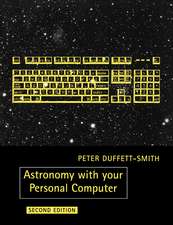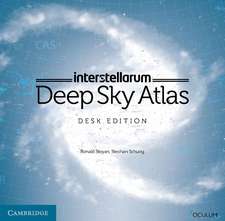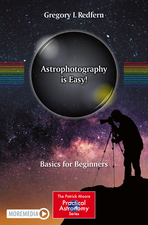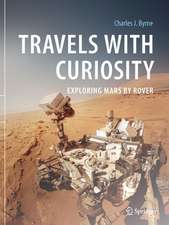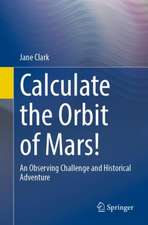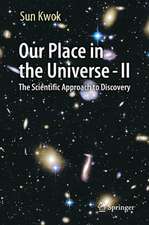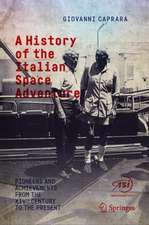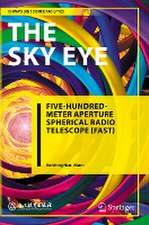Astronomical Discoveries You Can Make, Too!: Replicating the Work of the Great Observers: Springer Praxis Books
Autor Robert K. Buchheimen Limba Engleză Paperback – 28 mai 2015
amateur astronomer the following tools to replicate some of these seminal observations from their own homes:
With your own eyes: Use your own observations and measurements to discover and confirm the phenomena of the seasons, the analemma and the equation of time, the logic behind celestial coordinates, and even the precession of the equinoxes.
With a consumer-grade digital camera: Record the changing brightness of an eclipsing binary star and show that a pulsating star changes color as it brightens and dims. Add an inexpensive diffraction grating to your camera and see the variety of spectral features in the stars, and demonstrate that the Sun’s spectrum is similar to one particular type of stellar spectrum.
With a backyard telescope: Add a CCD imager and you can measure the scale of the Solar System and the distance to a nearby star. You could even measure the distance to another galaxy and observe the cosmological redshift of the expanding universe.
Astronomical Discoveries You Can Make, Too! doesn’t just tell you about the development of astronomy; it shows you how to discover for yourself the essential features of the universe.
Din seria Springer Praxis Books
-
 Preț: 294.46 lei
Preț: 294.46 lei -
 Preț: 223.45 lei
Preț: 223.45 lei -
 Preț: 193.12 lei
Preț: 193.12 lei -
 Preț: 167.85 lei
Preț: 167.85 lei -
 Preț: 288.98 lei
Preț: 288.98 lei -
 Preț: 323.74 lei
Preț: 323.74 lei -
 Preț: 401.38 lei
Preț: 401.38 lei -
 Preț: 264.12 lei
Preț: 264.12 lei - 8%
 Preț: 513.00 lei
Preț: 513.00 lei -
 Preț: 190.01 lei
Preț: 190.01 lei -
 Preț: 218.16 lei
Preț: 218.16 lei -
 Preț: 312.06 lei
Preț: 312.06 lei - 17%
 Preț: 414.05 lei
Preț: 414.05 lei -
 Preț: 216.41 lei
Preț: 216.41 lei -
 Preț: 262.27 lei
Preț: 262.27 lei -
 Preț: 264.35 lei
Preț: 264.35 lei -
 Preț: 167.63 lei
Preț: 167.63 lei -
 Preț: 284.81 lei
Preț: 284.81 lei -
 Preț: 259.08 lei
Preț: 259.08 lei -
 Preț: 305.47 lei
Preț: 305.47 lei -
 Preț: 244.14 lei
Preț: 244.14 lei -
 Preț: 227.85 lei
Preț: 227.85 lei -
 Preț: 285.25 lei
Preț: 285.25 lei -
 Preț: 295.56 lei
Preț: 295.56 lei -
 Preț: 357.17 lei
Preț: 357.17 lei -
 Preț: 275.79 lei
Preț: 275.79 lei -
 Preț: 257.08 lei
Preț: 257.08 lei -
 Preț: 349.71 lei
Preț: 349.71 lei -
 Preț: 272.45 lei
Preț: 272.45 lei -
 Preț: 270.27 lei
Preț: 270.27 lei - 8%
 Preț: 456.51 lei
Preț: 456.51 lei -
 Preț: 352.34 lei
Preț: 352.34 lei - 8%
 Preț: 394.80 lei
Preț: 394.80 lei -
 Preț: 320.65 lei
Preț: 320.65 lei -
 Preț: 325.29 lei
Preț: 325.29 lei -
 Preț: 253.11 lei
Preț: 253.11 lei -
 Preț: 192.86 lei
Preț: 192.86 lei -
 Preț: 313.40 lei
Preț: 313.40 lei -
 Preț: 150.51 lei
Preț: 150.51 lei -
 Preț: 233.34 lei
Preț: 233.34 lei -
 Preț: 286.78 lei
Preț: 286.78 lei -
 Preț: 212.01 lei
Preț: 212.01 lei -
 Preț: 366.83 lei
Preț: 366.83 lei -
 Preț: 299.99 lei
Preț: 299.99 lei -
 Preț: 232.27 lei
Preț: 232.27 lei -
 Preț: 284.58 lei
Preț: 284.58 lei -
 Preț: 212.45 lei
Preț: 212.45 lei -
 Preț: 159.81 lei
Preț: 159.81 lei -
 Preț: 349.48 lei
Preț: 349.48 lei - 20%
 Preț: 2061.64 lei
Preț: 2061.64 lei
Preț: 407.98 lei
Nou
Puncte Express: 612
Preț estimativ în valută:
78.08€ • 81.21$ • 64.46£
78.08€ • 81.21$ • 64.46£
Carte tipărită la comandă
Livrare economică 14-28 aprilie
Preluare comenzi: 021 569.72.76
Specificații
ISBN-13: 9783319156590
ISBN-10: 3319156594
Pagini: 475
Ilustrații: XIII, 549 p. 168 illus., 122 illus. in color.
Dimensiuni: 168 x 240 x 25 mm
Greutate: 0.89 kg
Ediția:2015
Editura: Springer International Publishing
Colecția Springer
Seriile Springer Praxis Books, Popular Astronomy
Locul publicării:Cham, Switzerland
ISBN-10: 3319156594
Pagini: 475
Ilustrații: XIII, 549 p. 168 illus., 122 illus. in color.
Dimensiuni: 168 x 240 x 25 mm
Greutate: 0.89 kg
Ediția:2015
Editura: Springer International Publishing
Colecția Springer
Seriile Springer Praxis Books, Popular Astronomy
Locul publicării:Cham, Switzerland
Public țintă
Popular/generalCuprins
Part I: Motions and Positions in the Sky.- Chapter 1: The Stars, the Sidereal and Solar Day, and the Seasons.- Chapter 2: Measuring Position and Describing Motion.- Part 2: The Moon.- Chapter 3: Introducing Earth's Satellite.- Chapter 4: The Moon in Three Dimensions, Occultations, and Parallax.- Chapter 5: The Moon’s Surface.- Part III: The Planets.- Chapter 6: Solar System Orbits.- Chapter 7: Planetary Phases and Moons.- Chapter 8: Scale and Light.- Part IV: The Stars.- Chapter 9: Observing Variable Stars.- Chapter 10: Barnard’s Star and the Copernican Model.- Part V: Astrophysics and Cosmology.- Chapter 11: Stellar Spectroscopy.- Chapter 12: Chapter 12: Solar Spectroscopy and the H-R Diagram.- Chapter 13: Our Galactic Neighbors.- Appendices.
Recenzii
“This is one of the most genuinelyexciting new astronomy books I’ve seen in a long time. It shows you, forexample, how you can use Galileo’s method to work out the height of mountainson the moon. … The time commitment and equipment requirements for each projectare well set out, and the projects are well explained. … this book a treat forthe armchair astronomer, but a real treasure trove for a team of committedexplorers.” (Andy Sawers, Astronomy Now, February, 2016)
Notă biografică
About the Author
Once upon a time, back in the days when the roar of Rocketdyne’s rocket-engine tests in the Santa Susanna mountains would roll through the San Fernando Valley like an earthquake, there was a small gang of fourth-graders who discovered that astronomy was a parent-approved reason to stay out in the backyard all night. We had an Edmund Scientific 3-inch reflector and a 2.5-inch Sears refractor. With them, we discovered the craters on the Moon, the rings of Saturn, and the moons of Jupiter, and we dreamed of a life spent studying the universe. I don’t remember ever seeing a galaxy or nebula, but I have vivid memories of watching the Perseid meteor shower, and less-vivid memories of the members of the gang helping each other to learn how to solve algebra problems.
Time passed, we dispersed to our various careers, and the stars themselves faded in the suburban sky. Then one Christmas, my wife decided that I might enjoy a telescope. That wonderful 6-inch Newtonian was a portal to new worlds: the beauty and mystery of the night sky, the community of the Orange County Astronomers, the craftsmen at the Riverside Telescope Makers Conference, larger telescopes (for deeper deep-sky observing), smaller telescopes (for asteroid occultations), CCD photometry, the Society for Astronomical Sciences, and a backyard observatory. I’ve been privileged to meet remarkable people (some famous, others unsung), see things that most people never witness, and learn about a wide range of phenomena, personalities, and possibilities. I hope that along the way – as Secretary of the Orange County Astronomers, a Board member of the Society for Astronomical Sciences, as a speaker, writer and mentor – I have been able to help other people expand their horizons as well. I wrote The Sky Is Your Laboratory as a way of helping other amateur astronomers try their hands at small-telescope research. The present book will, I hope, give amateur astronomers, students, and instructors a new way to learn about the beauty of the heavens and experience the history of astronomical discovery.
Bob Buchheim
December, 2014
Coto de Caza, CA
Once upon a time, back in the days when the roar of Rocketdyne’s rocket-engine tests in the Santa Susanna mountains would roll through the San Fernando Valley like an earthquake, there was a small gang of fourth-graders who discovered that astronomy was a parent-approved reason to stay out in the backyard all night. We had an Edmund Scientific 3-inch reflector and a 2.5-inch Sears refractor. With them, we discovered the craters on the Moon, the rings of Saturn, and the moons of Jupiter, and we dreamed of a life spent studying the universe. I don’t remember ever seeing a galaxy or nebula, but I have vivid memories of watching the Perseid meteor shower, and less-vivid memories of the members of the gang helping each other to learn how to solve algebra problems.
Time passed, we dispersed to our various careers, and the stars themselves faded in the suburban sky. Then one Christmas, my wife decided that I might enjoy a telescope. That wonderful 6-inch Newtonian was a portal to new worlds: the beauty and mystery of the night sky, the community of the Orange County Astronomers, the craftsmen at the Riverside Telescope Makers Conference, larger telescopes (for deeper deep-sky observing), smaller telescopes (for asteroid occultations), CCD photometry, the Society for Astronomical Sciences, and a backyard observatory. I’ve been privileged to meet remarkable people (some famous, others unsung), see things that most people never witness, and learn about a wide range of phenomena, personalities, and possibilities. I hope that along the way – as Secretary of the Orange County Astronomers, a Board member of the Society for Astronomical Sciences, as a speaker, writer and mentor – I have been able to help other people expand their horizons as well. I wrote The Sky Is Your Laboratory as a way of helping other amateur astronomers try their hands at small-telescope research. The present book will, I hope, give amateur astronomers, students, and instructors a new way to learn about the beauty of the heavens and experience the history of astronomical discovery.
Bob Buchheim
December, 2014
Coto de Caza, CA
Textul de pe ultima copertă
You too can follow in the steps of the great astronomers such as Hipparchus, Galileo, Kepler and Hubble, who all contributed so much to our modern understanding of the cosmos. This book gives the student or
amateur astronomer the following tools to replicate some of these seminal observations from their own homes:
With your own eyes: Use your own observations and measurements to discover and confirm the phenomena of the seasons, the analemma and the equation of time, the logic behind celestial coordinates, and even the precession of the equinoxes.
With a consumer-grade digital camera: Record the changing brightness of an eclipsing binary star and show that a pulsating star changes color as it brightens and dims. Add an inexpensive diffraction grating to your camera and see the variety of spectral features in the stars, and demonstrate that the Sun’s spectrum is similar to one particular type of stellar spectrum.
With a backyard telescope: Add a CCD imager and you can measure the scale of the Solar System and the distance to a nearby star. You could even measure the distance to another galaxy and observe the cosmological redshift of the expanding universe.
Astronomical Discoveries You Can Make, Too! doesn’t just tell you about the development of astronomy; it shows you how to discover for yourself the essential features of the universe.
amateur astronomer the following tools to replicate some of these seminal observations from their own homes:
With your own eyes: Use your own observations and measurements to discover and confirm the phenomena of the seasons, the analemma and the equation of time, the logic behind celestial coordinates, and even the precession of the equinoxes.
With a consumer-grade digital camera: Record the changing brightness of an eclipsing binary star and show that a pulsating star changes color as it brightens and dims. Add an inexpensive diffraction grating to your camera and see the variety of spectral features in the stars, and demonstrate that the Sun’s spectrum is similar to one particular type of stellar spectrum.
With a backyard telescope: Add a CCD imager and you can measure the scale of the Solar System and the distance to a nearby star. You could even measure the distance to another galaxy and observe the cosmological redshift of the expanding universe.
Astronomical Discoveries You Can Make, Too! doesn’t just tell you about the development of astronomy; it shows you how to discover for yourself the essential features of the universe.
Caracteristici
Presents a variety of easy yet fascinating projects to observe and measure celestial phenomena Offers step-by-step instructions for replicating pivotal discoveries in the history of astronomy Translates various physical laws that govern astronomy into observational plans that can be followed with a garden-variety telescope

